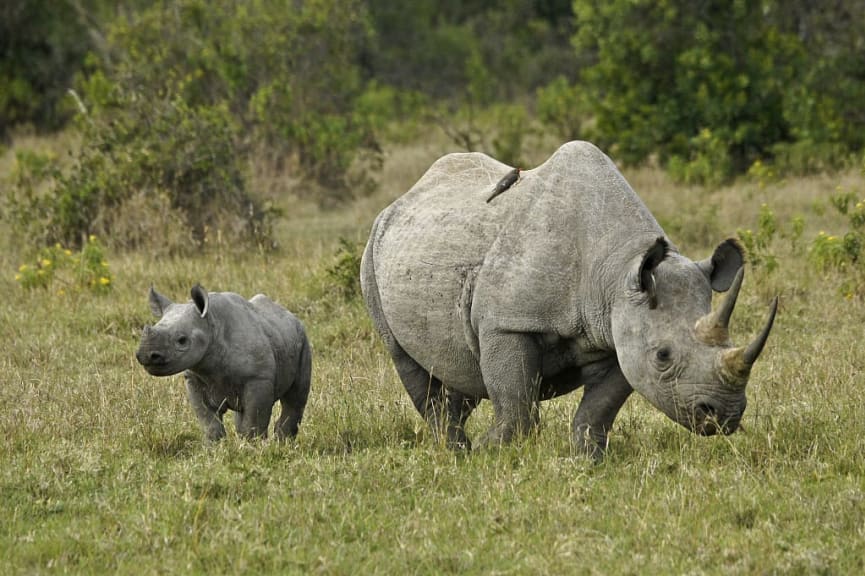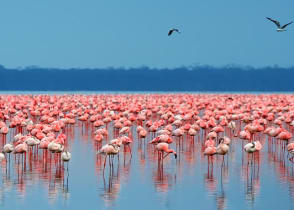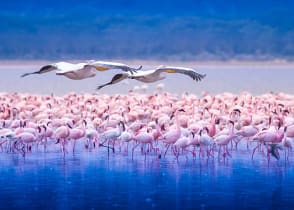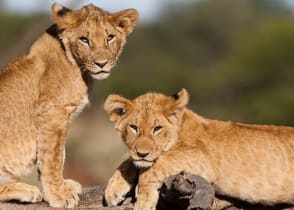10 Best Places to Visit in Kenya on Safari

Amboseli National Park, Kenya
Kenya’s stirring landscapes conjure the perfect image of an African safari setting, with dramatic mountain ranges, the majestic Great Rift Valley, glistening lakes, and vast open savannas, all part of the 10 best places to visit in Kenya on safari.
The topographical diversity is breathtaking, as you find yourself submerged in wildlife wonder. Witness dramatic events such as the Great Migration and Mara River crossing, and capture the iconic image of Mount Kilimanjaro. Add culture, cuisine, and overall charm, and you will understand why Kenya has a place on any safari-goers list.
The country’s colorful coastline compliments the browns and greens of the savannas and forests, making for the perfect beach and bush combination. Any safari in Kenya is an unparalleled experience, and below are the top 10 not-to-be-missed places for yours.
1. Maasai Mara National Reserve

Maasai Mara National Reserve, Kenya
Kenya’s famous Maasai Mara National Reserve offers one of the most outstanding safari experiences in Africa, its savannas and ravines, forests and river banks teeming with wildlife, captivating landscapes, and classic safari images.
The Mara is home to large numbers of predators, including more big cats per square mile than anywhere else. Kenya’s premier park boasts massive herds of wildebeest and myriad other game, with game drives conducted in every corner.
The Maasai people have a rich presence in the reserve, ensuring the conservation of this national treasure is managed well to ensure a symbiotic relationship between man and animal, while offering visitors an insight into their culture and heritage. Any safari itinerary in Kenya should include a safari in the Maasai Mara.
Why You Should Go: The Maasai Mara offers classic safaris in one of Africa’s most famous and wildlife-abundant reserves. It is known for its large population of cats and the Great Migration and crossing, one of Africa’s wonders. Discover the best ways to experience the breathtaking movement of wildlife with our guide on how to see the wildebeest Great Migration.
Recommended Length of Stay: 3-4 Days
Best Time to Visit: The drier season between June and September is the ideal time to experience this magnificent park, with late July, early August, and again in October he months in which to witness the natural spectacles on Great Migration safaris in Kenya.
2. Amboseli National Park

Amboseli National Park, Kenya
Amboseli offers the timeless image of elephants roaming across the savanna beneath majestic Mount Kilimanjaro.
You may spot lions, grazers, and buffalos rolling around in mud baths, with a chance to step out onto Observation Hill to admire the exquisite view that surrounds you. A sprinkle of acacia trees offers a little shade on a sunny day, while Lake Amboseli sees wildlife coming to drink and birdlife prolific.
Amboseli National Park is often combined with a Maasai Mara visit, creating an outstanding safari package that offers contrasting experiences within one classic adventure during the best time to visit Kenya.
Why You Should Go: The view of Mount Kilimanjaro is arguably best from Amboseli. Enormous elephant herds roam the park’s plains and birdlife is prolific.
Recommended Length of Stay: 2-3 Days
Best Time to Visit: June through September is a wonderful time to be in Amboseli. The weather is dry and mild.
3. Samburu National Reserve

Samuru National Reserve, Kenya
Wrapping itself around mountain slopes and alpine plateaus, the land of the Samburu is entirely untouched by modernity and home to an eclectic mix of Africa's great mammals.
Samburu offers safari-goers a chance to see the rare “Samburu Six”, reticulated giraffe, long-necked gerenuk, Gunther’s dik-dik, the Somali ostrich, Grevy’s zebra, and the beisa oryx.
This is old Africa, with a strong sense of community involvement notable in most of the reserve.
Activities in Samburu include walking safaris with warrior guides and animal viewing from the back of a mountain bike. A visit to a Samburu tribal village rounds off your Samburu National Reserve experience.
Why You Should Go: A lesser-frequented reserve, rich with elephant life and an array of plains’ game and wild dogs, plus a chance to see the “Samburu Six”. Discover the culture of the Samburu people and admire the many flower species found here, with various ways to explore the landscape and wildlife. Learn more about how to explore with our types of African safaris: different ways to experience a safari.
Recommended Length of Stay: 2-3 Days
Best Time to Visit: June to September is excellent for game viewing and December to March brings terrific wildlife. It is best to avoid the wet season, which sees light rain in November and heavy rain in April and May.
4. Lake Nakuru National Park

Lake Nakuru National Park, Kenya
Lake Nakuru is an ecologically diverse experience within the Great Rift Valley, boasting some of Kenya’s best birdlife and offering landscapes that range from open plains to picturesque mountain ranges.
Beauty meets nature and an abundance of wildlife, waterfalls, and viewpoints impress, and spotting flamingos on the lake from Baboon Cliff is mesmerizing. Waterbuck, reedbuck, and hippos also delight.
An approximately three-hour drive from Nairobi, Lake Nakuru should be on any visitor’s list, with opportunities such as euphorbia forest walks, spotting the near-threatened Rothschild’s giraffe, and embracing its rich and fascinating birdlife. Add to all this its mild climate and you will see why Lake Nakuru is a popular destination for many Kenyan safari-goers.
Why You Should Go: Splashes of pink dictate the landscape, the large flamingo population the main draw. There’s also the chance to witness the near-threatened Rothschild’s giraffe and gaze at beautiful waterfalls. The wildlife is diverse and plentiful, and you can find out more about the animals you may find in Lake Nakuru and beyond with our top animals in Kenya and where to see them.
Recommended Length of Stay: 1-2 Days
Best Time to Visit: June to March is great for general game viewing, with January and February fantastic for birdlife and the birthing season.
5. Laikipia Plateau

Ol Pejeta Conservancy, Kenya
Stretching across Kenya’s north, the Laikipia Plateau hides some of the country's most exclusive and unique experiences in vast wilderness in which you can embark on walking safaris.
It is home to the rare and elusive, and you will hardly see another person or encounter a vehicle as you explore. Whether a safari enthusiast or a first-timer, this mix of rare species and open space makes Laikipia a legendary destination, with wildlife stretching over a vast area that celebrates diversity and quality rather than quantity.
Discover Ol Pejeta, a non-profit wildlife conservancy in Laikipia County. Nestled between the foothills of the Aberdare mountain range and Mount Kenya, Ol Pejeta is the only park where you have a chance to see the Big Five and chimpanzees in one visit. Learn more about the variety of wildlife with information on the Big Five, the Little Five, and how to see them.
Why You Should Go: Ol Pejeta is a popular conservancy in Laikipia that is open to day visitors. The Sweetwater Chimpanzee Sanctuary is located here and visitors can learn much about wildlife conservation.
Recommended Length of Stay: 1-2 Days
Best Time to Visit: June to September are the drier winter months and a great time to visit. Some lodges may be full over this time and in the December to March season, when bird watching is excellent and the birthing season is in full swing. Avoid April, May, and November, when roads will be muddy and access more difficult.
6. Mount Kenya National Park

Mount Kenya National Park, Kenya
A majestic snowcapped mountain with primates roaming through the lower-altitude forest, Mount Kenya represents Africa’s second-highest peak and is listed as a Unesco World Heritage Site, featuring a dozen glaciers.
The hiking trails receive far fewer footsteps than Kilimanjaro and you get to experience walking across snow for sublime views over iconic plains. Discover the park’s moorlands and forests, and embrace its rich biodiversity.
Black-and-white colobus monkeys and buffalo are among the attractions as you ascend through the lower-altitude forest, before crossing a lunar-like landscape that blurs into the snow line. Exploring is on foot, preserving the pristine environment and presenting a quieter experience overall.
Why You Should Go: Explore on foot, discover immense beauty, and enjoy colobus monkey sightings. Mount Kenya is a Unesco World Heritage Site.
Recommended Length of Stay: 2-3 Days (including time to acclimatize)
Best Time to Visit: December to March is sunny and warmer, and the ideal time to visit.
7. Tsavo East & West National Parks

Tsavo East National Park, Kenya
Together, these parks form one substantial region, their incredible size culminating in one of the most biodiverse ecosystems in Kenya.
Tsavo East is a haven for birdlife and antelope sightings, while Tsavo West, Kenya’s second-largest national park, presents a volcanic landscape of jagged rocks. The Mzima Springs bring relief to the thirsty land, creating the foundation for forest palms and fever trees, with captivating views of the Chyulu Hills seemingly balancing it all out.
The breathtaking landscape is complimented by outstanding game viewing. The intriguing red tuskers, elephants coated in a rouge dust earning them this name, are a highlight in this region, while hippos and crocodiles are regularly seen during game activities. Home to many cheetahs and big cats, the Tsavo parks are excellent destinations for cheetah safaris in Kenya.
Why You Should Go: Enjoy walks to the Mzima Springs and spot the red tuskers. Breathtaking views of Mount Kilimanjaro can be enjoyed on a clear day. Consider Tsavo West over its eastern counterpart.
Recommended Length of Stay: 2-3 Days
Best Time to Visit: June to October is the dry season and great for general wildlife viewing. January and February are excellent for birding. Avoid the rainy months of November, April, and May.
8. Lake Naivasha National Park

Lake Naivasha, Kenya
Noted as the highest lake in the Rift Valley, fresh-water Lake Naivasha is just north of Nairobi. Meaning “rough water”, the area can see storms that add drama to the overall experience.
Hippos, fish, and a variety of birds spend their days creating chaos in spectacular fashion. Zebras, hippos, and giraffes graze freely, while the fish eagle’s call gives way to a magnificent orchestra of bird sounds.
Visiting Lake Naivasha can be done as a day trip, as it lies around two hours from Nairobi. The surrounding farmland contrasts the wildlife within and visitors can explore more of the area with a hike in Hell’s Gate National Park.
Why You Should Go: The region is beautiful and only a two-hour scenic drive from Nairobi. It is located between the Maasai Mara and Lake Nakuru, so perfect for adding as a third safari location.
Recommended Length of Stay: 1-2 Days
Best Time to Visit: From June to March, the area experiences little rain, making this a good time for general game viewing. The high season is in December and January, when a lot of families tend to visit.
9. Aberdare National Park

Aberdare National Park, Kenya
The Aberdare mountain range makes for a spectacular trekking experience, as well as a photographer’s delight. It is a picturesque area featuring steep forest ravines, magnificent waterfalls, and open moorland.
Elephants, spotted hyenas, the elusive bongo antelope, and baboons are just some of the wildlife you would expect to see in the Aberdare National Park. The birdlife is prolific here, with the chance to enjoy a picnic or some trout fishing to round off a magical stay in this part of the Rift Valley.
Sleep in tree-top accommodations and enjoy the night sounds from above. Savor outstanding cuisine and embrace local culture, highlights of a visit to the park.
Why You Should Go: The drive to Aberdare is around two hours from Nairobi, so can be visited as a day trip. It comprises a wonderful rainforest and moorland plateau. Embrace the chance to sleep in tree-top accommodations. The type of accommodations you stay in could further immerse you in the environment and our types of safari accommodations and how to choose will give you more information on ways to have a unique experience.
Recommended Length of Stay: 1-2 Days
Best Time to Visit: July to October is dry and the roads are easier to navigate. These are also the coolest months of the year.
10. Mombasa & the Coast

Diani beach, south of Mombasa, Kenya
Known as the “blue and white city”, coastal Mombasa is a blend of cultures, languages, and cuisine from India, Arabia, and Africa. It is a cosmopolitan port offering beach breakaways that soothe the soul and pique the interest of history enthusiasts.
Spice markets and ancient forts complement each other, while luxury accommodations offer the chance to get away from it all or simply reminisce about your Kenyan safari.
Activities include old-town walking tours, a chance to visit markets, and enjoy horseback and camel riding. Visit the Marine National Park and explore reefs and inviting azure waters.
Why You Should Go: This is a perfect beach combination with a Kenyan safari and a cultural delight. By staying within Kenya, only one visa is required and it is not far from Nairobi. Explore more amazing beach and wildlife possibilities with our amazing African safari and beach holidays.
Recommended Length of Stay: 3-5 Days
Best Time to Visit: Post-safari is ideal, meaning any time from June to October. The weather will be warmer in September and October, and you will be just ahead of the rainy season.
Explore the Best Places to Visit in Kenya on Safari

Lewa Wildlife Conservancy, Kenya
Kenya offers endless natural beauty and dramatic settings, enhanced by the wonders of wandering wildlife. Every safari experience is unique and your trip will dazzle with diversity, immersing you in fascinating, untamed ecosystems, from the shadows of Mount Kenya to the splendor of the Great Rift Valley.
Get inspired with our Kenya safaris and look for more ideas about the best time to visit, what to do, and more with our Kenya safari guide. Speak to a Zicasso Kenya safari specialist when you are ready to start planning your trip.
Life-Enriching Travel Designed Just for You
- 1
Trips curated by the world’s top destination experts
- 2
Concierge-level service leading up to and during your trip
- 3
Unique, exclusive experiences and insider access





